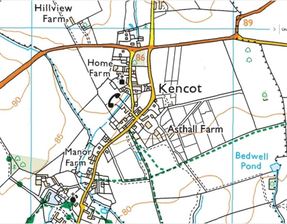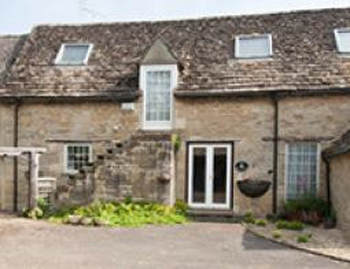Past times in Kencot
Data protection information
|
This is a look back in the history of Kencot, about some of the houses in the village.
Dosset Old School
The Village School (now Dossett Old School House)
The Village school closed when May’s father was a child. The village children then attended the school in Broadwell. (Stella’s grandfather went to Alvescot School). |
May and the other Kencot children at the time, went to Broadwell School. She loved her teacher, Miss Eltham, who lived in the school house. Diana thinks it was Miss Eltham who was the carrier for the diphtheria that affected some of the children in Broadwell School.
In the war, evacuees came to the village, and were billeted around the village. Some teachers came with them. The children sometimes found country life very different, i.e. bucket toilets rather than flushing loos!
The evacuees and the local children got on ‘as well as anyone does today’ (Leonard) and May says ‘the evacuees taught the locals some things and the locals taught the evacuees some things.
May said that the children had a lovely life with lots of freedom to play in the fields. Nigel Walker’s ‘Grampie’ was the farm bailiff and was very lenient about the children playing on the land.
In the war, evacuees came to the village, and were billeted around the village. Some teachers came with them. The children sometimes found country life very different, i.e. bucket toilets rather than flushing loos!
The evacuees and the local children got on ‘as well as anyone does today’ (Leonard) and May says ‘the evacuees taught the locals some things and the locals taught the evacuees some things.
May said that the children had a lovely life with lots of freedom to play in the fields. Nigel Walker’s ‘Grampie’ was the farm bailiff and was very lenient about the children playing on the land.
The Malthouse
The Malthouse was originally a small independent farm.
The Forshews lived in the Malthouse. They lived in one part of the house. The wing facing the road wasn’t lived in at the time but allowed to decay. During WWII soldiers were billeted in the long wing and barns of the Malthouse.
The Forshews had 4 children, Bernice (who died of diphtheria at five years old), Ralph, John and Grace.
Mrs. Forshew was Mary Minnie Oakey before her marriage and was a very forthright woman. Mr Forshew was quiet.
The rest of the Malthouse outbuildings – now the two barn conversions, were used for storage, and a place where the villagers came to buy fresh eggs from the chickens Mr Forshew kept on the land.
At some points in the past, there might have been families living in the barns, ‘camping out’ as May described it.
May remembers the children playing in the barns, and up and down the tallets (outside steps).
Mrs Forshew used to drive for miles around the villages in her pony and trap. (The pony had belonged to the rag and bone man and was given to Anne Oakey’s family when he retired but, when it proved to be difficult to ride was passed on to Mary Forshew).
The Forshews lived in the Malthouse. They lived in one part of the house. The wing facing the road wasn’t lived in at the time but allowed to decay. During WWII soldiers were billeted in the long wing and barns of the Malthouse.
The Forshews had 4 children, Bernice (who died of diphtheria at five years old), Ralph, John and Grace.
Mrs. Forshew was Mary Minnie Oakey before her marriage and was a very forthright woman. Mr Forshew was quiet.
The rest of the Malthouse outbuildings – now the two barn conversions, were used for storage, and a place where the villagers came to buy fresh eggs from the chickens Mr Forshew kept on the land.
At some points in the past, there might have been families living in the barns, ‘camping out’ as May described it.
May remembers the children playing in the barns, and up and down the tallets (outside steps).
Mrs Forshew used to drive for miles around the villages in her pony and trap. (The pony had belonged to the rag and bone man and was given to Anne Oakey’s family when he retired but, when it proved to be difficult to ride was passed on to Mary Forshew).
De Rougemont
Mr. De Rougemont had the house built in October 1927.
May’s paternal grandmother lived in the cottage opposite. (Now Shill House) May recalls her mother telling her that she left Gran’s house when she was in labour with May’s brother and walked past the workmen working on De Rougement. May’s mother tried not to show them she was in labour. Her brother was born in 1927 which is how May is so sure of the date the house was built.
The De Rougement sisters were Helen and Biddy. May says they were much loved by the people of the village. She and Leonard remember many happy hours spent in their house with other children from the village, dressing up, doing plays, playing games. They had a wonderful collection of clothes in the dressing-up box.
The sisters were lovely people, one tall and thin, the other short and round. Gill’s mother worked for them, cleaning and tidying etc. When the sisters died, Gill’s mum found lots of papers showing how the sisters were always raising funds for the Coal and the nursing funds. One learned to drive – a green Ford. There were only 4 cars in the village at that time.
May’s paternal grandmother lived in the cottage opposite. (Now Shill House) May recalls her mother telling her that she left Gran’s house when she was in labour with May’s brother and walked past the workmen working on De Rougement. May’s mother tried not to show them she was in labour. Her brother was born in 1927 which is how May is so sure of the date the house was built.
The De Rougement sisters were Helen and Biddy. May says they were much loved by the people of the village. She and Leonard remember many happy hours spent in their house with other children from the village, dressing up, doing plays, playing games. They had a wonderful collection of clothes in the dressing-up box.
The sisters were lovely people, one tall and thin, the other short and round. Gill’s mother worked for them, cleaning and tidying etc. When the sisters died, Gill’s mum found lots of papers showing how the sisters were always raising funds for the Coal and the nursing funds. One learned to drive – a green Ford. There were only 4 cars in the village at that time.
The Old Stable
Until the early 1970s, The Old Stable was originally a birthing stable for Broadwell Manor Farm. It was sold by the Goodenoughs to their friend Brenda Colvin, (born: 8 June 1897: Died: 27 January 1981 (aged 83)) the landscape architect who was based in Filkins (Colvin & Moggeridge).
She had the barn converted into a home, with living quarters upstairs, and sleeping quarters downstairs. It was her partner Hal Moggeridge with his family who first lived in the house. |
The house still retained features of it's previous existence, including outside steps to the hay storage area, lintels, horse hitching ironwork and hay baskets.
Subsequent owners have changed the layout, extended the original barn (nearly doubling it's size) and changed the roofline.
Subsequent owners have changed the layout, extended the original barn (nearly doubling it's size) and changed the roofline.
The Playground
The playground was built in 1937. Before that it was just a field.
The village had two cricket grounds at that stage. One was behind the Eustaces and was fenced off so the animals couldn’t get on it. May says it was a sacrosanct place.
Leonard told us that on the playground there were no football posts, but there were rugby posts pinched by Leonard and his mates from the nearby airfield when it was closed.
The village had two cricket grounds at that stage. One was behind the Eustaces and was fenced off so the animals couldn’t get on it. May says it was a sacrosanct place.
Leonard told us that on the playground there were no football posts, but there were rugby posts pinched by Leonard and his mates from the nearby airfield when it was closed.
Reminiscences of Red Rose Close
Red Rose Close contained 3 to 4 alms houses, Mrs Wilks lived in the top house, just one downstairs and one upstairs room. The other houses were the same. They all shared one well for all their water.
Mr Barney married twice. His first wife died. Not known what he did. He lived at 1 Red Rose Close where later the Augers lived. Thought he might have been a writer. He got us singing at the door for ages writing down the words. May didn't know him to go to work. His second wife and he used to ride a tandem. A young lad lived in the house with them. He was disabled. He used to appear sometimes when the children were playing in the playground then disappear again.
Mr Bradley Clack rode a bike and was knocked off it one day and was killed. He lived in the third house in the row, and worked on the Bradwell Grove estate.
Mr Barney married twice. His first wife died. Not known what he did. He lived at 1 Red Rose Close where later the Augers lived. Thought he might have been a writer. He got us singing at the door for ages writing down the words. May didn't know him to go to work. His second wife and he used to ride a tandem. A young lad lived in the house with them. He was disabled. He used to appear sometimes when the children were playing in the playground then disappear again.
Mr Bradley Clack rode a bike and was knocked off it one day and was killed. He lived in the third house in the row, and worked on the Bradwell Grove estate.
Village Shops
Gable Ends (see photo) was the home of the village shop – owned by the Godwins. Annie recalls Mr Godwin going around the village on Thursdays selling things including sweets.
One shed was for oil and paraffin and two bigger sheds for food and mending bikes and charging up the radios.
The butcher’s shop was at Well House. and Ivy Nook was rumoured to be a drinking house, although no one at the meeting could remember this!
One shed was for oil and paraffin and two bigger sheds for food and mending bikes and charging up the radios.
The butcher’s shop was at Well House. and Ivy Nook was rumoured to be a drinking house, although no one at the meeting could remember this!
Copyright © 2018

